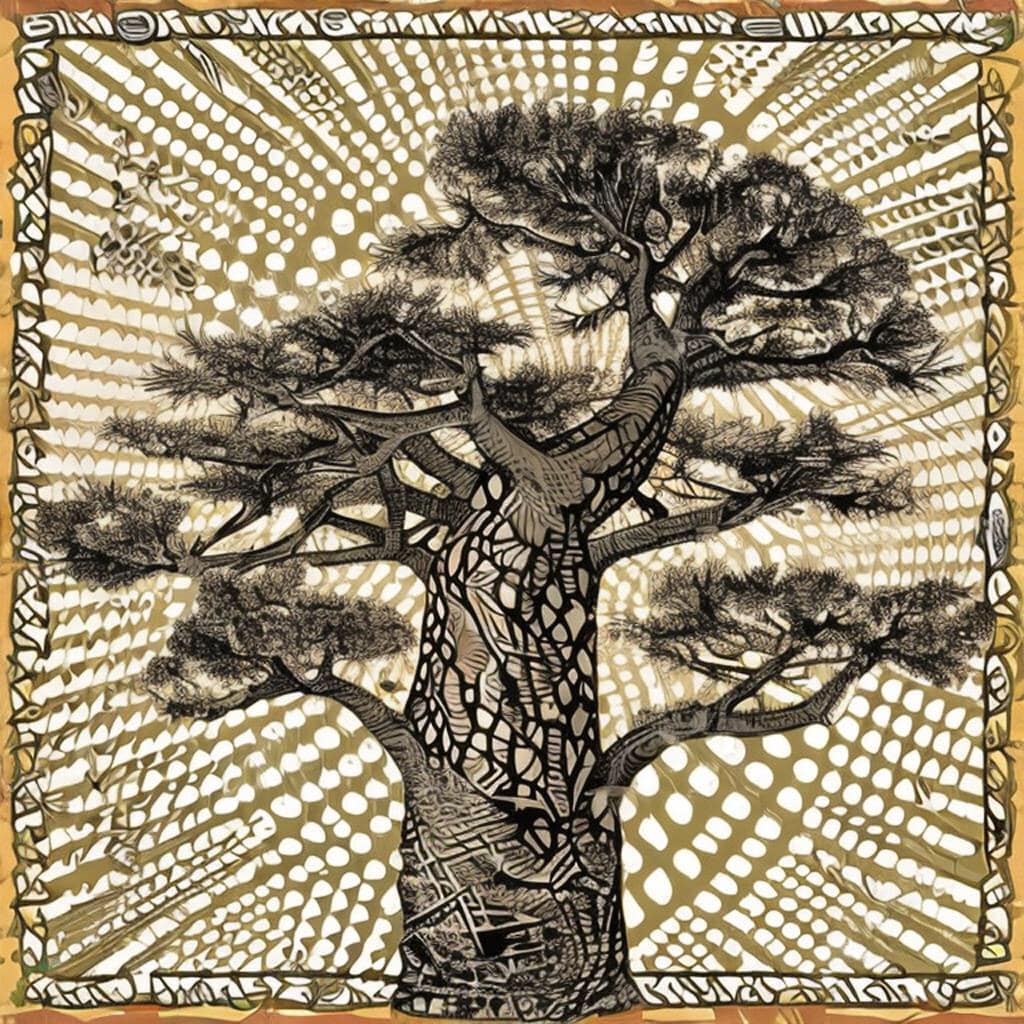Sacred trees in Madagascar
Madagascar is home to a diverse array of plant and animal species, including many unique and endemic trees that are considered sacred by the Malagasy people. These trees are often associated with spiritual significance and are the focus of many rituals and ceremonies.
In many Malagasy cultures, sacred trees are believed to be the homes of ancestral spirits or “razana”. People may offer food, drink, or other offerings to these spirits as a way of seeking their blessings or protection. Trees are also used as places of worship, and people may gather under the shade of a sacred tree to pray, sing, or perform other religious ceremonies.
In some Malagasy cultures, certain trees are believed to have healing properties. The bark, leaves, or fruit of these trees may be used to treat a wide range of ailments, from fever to stomach problems. Some of these trees have even been used to create traditional medicines that are still used today.
Sacred trees have also played an important role in the art and literature of Madagascar. They are often depicted in carvings, paintings, and other forms of art, and their beauty and symbolism have inspired many artists over the years.
Unfortunately, many of Madagascar’s sacred trees are at risk due to deforestation, climate change, and other environmental threats. This has led to efforts to protect and preserve these trees, both for their cultural significance and for their ecological value.
Efforts to protect sacred trees in Madagascar include the establishment of protected areas, the promotion of sustainable forestry practices, and the education of local communities about the importance of preserving their cultural heritage. By working together to protect these trees, we can ensure that they continue to play an important role in Malagasy culture for generations to come.
In Madagascar, several sacred trees hold spiritual significance for the local people
Let us have a closer look.
The Ranomafana Tree
The Ranomafana tree is a species of mango tree that is considered sacred by many people in Madagascar. It is believed to have protective powers and is often used in traditional medicine to cure various ailments.
The Ranomafana tree, scientifically known as Mangifera indica, is not just a species of mango tree but a vital cultural and ecological symbol in Madagascar. This tree holds significant spiritual importance for many communities in the region, where it is believed to be endowed with protective qualities and serves as a guardian of the land.
Cultural Significance
Sacredness: Many local communities view the Ranomafana tree as sacred. It often features in rituals and ceremonies, symbolizing life, fertility, and harmony with nature. Residents may plant these trees near homes or in communal areas to invoke blessings and protection.
Folklore and Legends: The tree is often embedded in local folklore, with stories passed down through generations regarding its origins and the mystical qualities attributed to it. These narratives elevate the tree’s status beyond that of a mere fruit-bearing plant, framing it as a symbol of ancestral wisdom and connection to the land.
Medicinal Use
Traditional Remedies: The Ranomafana tree’s leaves, bark, and fruit are utilized in traditional medicine to treat various ailments, such as fevers, digestive issues, and skin disorders. Herbalists and traditional healers may prepare infusions or poultices, drawing on the tree’s perceived healing properties.
Holistic Approaches: The use of the Ranomafana tree in traditional medicine often reflects a holistic approach to health, where the treatment involves not only the physical but also spiritual well-being. This may include prayers, songs, or other rituals performed alongside the medicinal applications.
Ecological Importance
Biodiversity: As a native species, the Ranomafana tree plays a crucial role in the local ecosystem, providing habitat and sustenance for various wildlife, including birds, insects, and small mammals. Its presence contributes to the overall biodiversity of Madagascar.
Conservation Efforts: Given the ecological significance and cultural value of the Ranomafana tree, efforts may be underway to protect it from deforestation and habitat destruction, ensuring that future generations can continue to benefit from its resources and heritage.
Agriculture and Economy
Sustainable Practices: Communities may engage in sustainable practices to cultivate the Ranomafana tree, balancing the need for agricultural production with the desire to preserve this revered species. This can foster a deeper connection between the people and their environment.
Local Economy: The fruit produced by the Ranomafana tree is not only a dietary staple but also has potential economic value, contributing to local markets. The cultivation and sale of mangoes can support small farmers and bolster rural economies.
In summary, the Ranomafana tree represents a confluence of cultural, medicinal, ecological, and economic dimensions in Madagascar. Its significance extends beyond its physical attributes, weaving together the threads of community identity, traditional practices, and environmental stewardship.
The Baobab Tree
The baobab tree is a species of tree that is found throughout Madagascar and is considered sacred by many people in the country. It is associated with life, strength, and longevity, and is believed to have the power to ward off evil spirits. The tree is often used in traditional medicine and its fruit and bark are used in various rituals and ceremonies.
The baobab tree, scientifically known as Adansonia, is not only a remarkable specimen of nature but also a symbol of cultural significance in Madagascar. These trees can live for over a thousand years and grow to impressive sizes, with trunks that can reach enormous diameters. This longevity, coupled with their distinctive appearance, has earned them the nickname tree of life.
In Madagascar, the baobab is deeply intertwined with the spiritual beliefs and practices of its people. It is often regarded as a sanctuary for ancestral spirits, and many communities believe that the tree serves as a bridge between the living and the deceased. As such, it is common for rituals to be conducted in its presence, offering prayers and sacrifices to honor ancestors and seek their guidance.
The tree’s fruit, known as monkey bread, is not only nutritious but also plays a vital role in local diets. This nutrient-rich fruit is packed with vitamin C, antioxidants, and other essential nutrients, making it a valuable resource in rural areas. Additionally, the dried fruit pulp is used to make refreshing beverages, while the seeds can be ground into flour.
The bark of the baobab tree is utilized in various traditional practices. It can be woven into ropes, mats, and baskets, showcasing the tree’s versatility. Moreover, the bark is sometimes used in traditional medicine to treat a variety of ailments, including fever, inflammation, and digestive issues. The leaves, flowers, and young shoots are also used in various medicinal concoctions.
The baobab’s unique ecological role cannot be overlooked either. It provides shelter and sustenance for numerous animal species, including birds, insects, and mammals. Its flowers attract various pollinators, further contributing to the biodiversity of the region.
In recent years, efforts have been made to raise awareness about the conservation of the baobab tree, as deforestation and climate change pose significant threats to its survival. Various organizations and local communities are working together to protect these iconic trees, recognizing not only their ecological value but also their cultural and spiritual significance.
In summary, the baobab tree is much more than just a tree; it embodies a wealth of cultural heritage, ecological importance, and medicinal value, making it a true treasure of Madagascar. Its preservation is essential for maintaining the cultural identity of the Malagasy people and the ecological balance of the region.
The Tamarind Tree
The tamarind tree is a species of tree that is found throughout Madagascar and is considered sacred by many people in the country. It is associated with spiritual purification and protection, and its fruit is used in traditional medicine and its bark is used in various rituals and ceremonies.
The tamarind tree, scientifically known as Tamarindus indica, is a significant species found not only in Madagascar but also in various tropical regions around the world. In Madagascar, the tamarind is revered for its cultural, medicinal, and ecological importance, leading many communities to consider it a sacred tree.
The tamarind tree is often associated with spiritual purification and protection. Its leaves, bark, and fruit are used in numerous traditional ceremonies aimed at cleansing the spirit and warding off negative influences. For many Malagasy people, the tamarind acts as a protective symbol, and its presence is thought to bring harmony to the environment and safety to households. Rituals involving the tamarind may include offerings to ancestral spirits, prayers for health and prosperity, and special celebrations during key life events such as births and marriages.
The fruit of the tamarind tree, which is a pod-like structure containing a tangy pulp, is highly valued not only for its taste but also for its medicinal properties. The pulp is rich in vitamins and antioxidants and is commonly used to prepare a variety of traditional dishes and beverages. In herbal medicine, tamarind is believed to have numerous health benefits, including aiding in digestion, reducing fever, and alleviating inflammation. Its natural laxative properties are especially sought after in treating gastrointestinal issues. Additionally, tamarind leaves and seeds are sometimes used in poultices to treat skin conditions and wounds.
Beyond its medicinal uses, the tamarind tree also plays a crucial role in the local ecosystem. Its broad canopy provides shade and habitat for various wildlife, including birds and insects. The tree’s flowering season attracts pollinators, contributing to the biodiversity of the region. Furthermore, tamarind trees are often planted in agroforestry systems to improve soil health and provide benefits to surrounding crops, showcasing their importance in sustainable agricultural practices.
The bark of the tamarind tree is another vital resource. Traditionally, the bark is harvested for various purposes, including the creation of ropes, baskets, and traditional musical instruments. In spiritual practices, tamarind bark may be used in rituals to symbolize strength and resilience, reinforcing its connection to protection and purification.
As with many natural resources, the tamarind tree faces threats from deforestation, climate change, and overharvesting. Initiatives aimed at conserving both the tamarind tree and its cultural significance are essential to ensuring that future generations can continue to benefit from its many uses. Local communities are often engaged in sustainable practices that not only protect the trees but also promote biodiversity and cultural heritage.
In summary, the tamarind tree stands as a multifaceted symbol of life and spirituality in Madagascar. Its contributions to traditional medicine, cultural rituals, and the ecosystem underscore the need to preserve this important species. By doing so, we can honor the deep connections between the tamarind tree and the Malagasy people, ensuring that its legacy continues to thrive.
These are just a few examples of the many sacred trees found in Madagascar, each with its own unique symbolism and significance. For many people in Madagascar, trees are seen as living beings with their own spirits, and their presence and protection is considered essential for the well-being of the community.
Shop tip
Sacred trees in Madagascar On Amazon

Thank you for likes, shares and comments! 🌳🌴🌲🌵
Source OpenAI’s chatGPT Language Models, Dalle, AI trot and Fleeky
images Picsart and MIB
Invest in your future
Take time to learn
Embark on your journey in affiliate marketing and website creation alongside an incredible community and myself. Invest in your future by dedicating time to learn and earn. Take all the time you need to master the basics before aiming higher. Give it a try and sign up for free. You won't regret it! Discover the possibilities for yourself...


